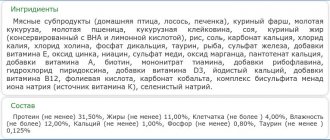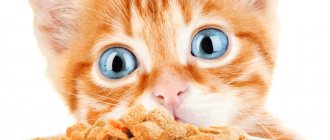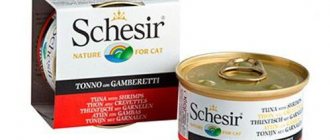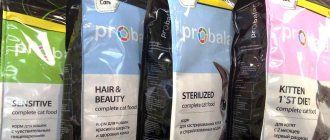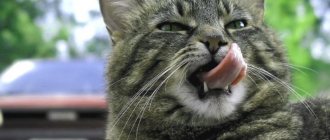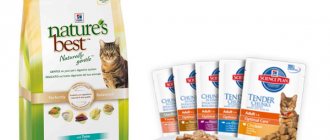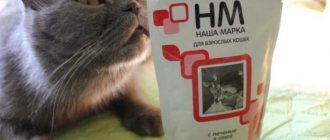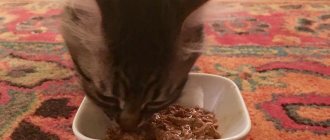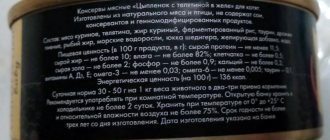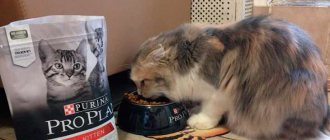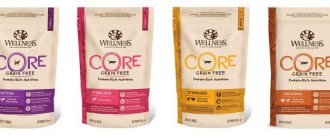Friskies food for cats was developed by experts from Nestle PURINA®*, a company that has been producing food for pets for over 85 years. Complete, balanced food offered by this company is suitable for feeding animals of any age and gender, as well as for feeding sterilized and neutered male cats.
Review of Friskies cat food
Friskies cat food is a budget option. This is one of the cheapest feeds, since its production uses by-products - in other words, waste - and a large amount of grains.
Friskies packaging is easily recognizable by the image of a cute red cat or playing kittens. The contents of the box, bag or pouch are no different from other economy options: multi-colored pads of dry food with a specific, easily recognizable smell or slices of wet food in gravy.
There will be no problems purchasing this food: unlike premium food, which can be purchased either in a specialized store or by ordering online, Friskies is sold in all supermarkets in our country.
Product range
One of the important advantages of Friskies products is their wide range. The line of food includes food for babies, older cats, and adult animals - both non-castrated and those that have undergone the sterilization procedure. The choice of flavors is also pleasing: even if your pet is very scrupulous in choosing food, you will certainly be able to choose the one that he likes.
Dry food for kittens
For our little pets, Friskies produces a special food that provides an easy and painless transition from mother cat milk to “adult” food. This is a complete, balanced diet that is suitable for kittens and adolescents in the first year of life.
The meat of domestic chicken, vegetables, vitamins and microelements contained in this type of food provides babies with all the nutrients necessary for their age:
- protein necessary for the development of bone and muscle tissue;
- taurine, beneficial for vision and the cardiovascular system;
- Vitamin D and minerals that help keep your kitten's teeth strong, sharp and healthy;
- vitamin E, which strengthens the body's resistance.
Wet food for kittens
If your pet is too small and weak to handle hard kibble of dry food, or he absolutely does not like it, you can offer him soft food with chicken, grains and fish.
In addition to the above components, Friskies wet food contains:
- vitamins A and D;
- amino acids;
- minerals;
- sugar.
The basic composition of dry and wet food is almost identical, so by choosing any of them, you can be sure that your baby is getting all the nutrients he needs at his age.
Dry food for adult cats
This is a complete food for animals over 1 year of age. The composition of dry food for adult cats implies the presence of:
- cereals;
- meat and offal;
- vegetables and their processed products;
- vegetable protein;
- oils;
- fats;
- yeast;
- vitamins;
- minerals;
- antioxidants.
In addition, there are dyes and preservatives, which are essential for economy-class food.
Wet food for adult cats
Your pet will certainly love the appetizing pieces in a fragrant gravy or tasty jelly.
The nutritional value of wet food intended for feeding adult animals does not differ from the same indicators for dry food.
Dry food for domestic cats
Complete nutrition for animals living in an apartment includes:
- chicken meat and offal;
- cereals;
- green peas (dry);
- vegetable proteins;
- oils;
- fats;
- vitamins;
- microelements;
- yeast;
- antioxidants.
And, as usual, when producing a budget version of cat food, it was not without dyes and preservatives.
Dry food for sterilized cats
Castrated cats and sterilized cats need less calories compared to their unoperated counterparts and, especially, young playful animals. This is due to hormonal changes that are inevitable after sterilization. Even previously very active animals become much calmer, more sedate, slower, and of all the available entertainment they prefer to sleep peacefully in the sun. Lack of physical activity negatively affects the health of cats: they quickly gain excess weight, which leads to heart problems and puts additional stress on their joints.
To avoid such problems from your pet, you need to provide him with sufficient physical activity and give him the right food.
Friskies for sterilized cats is a complete nutrition with:
- dietary rabbit meat and offal;
- cereals;
- vegetables (dried green peas);
- vegetable protein;
- oils;
- fats;
- vitamins;
- minerals;
- yeast;
- antioxidants.
The calorie content of this food is significantly lower than others, but it saturates very well.
Dry food for hairball control
Cats are amazingly clean creatures. No matter how much you comb their fluffy fur, no matter how clever furminators you use, our favorites will lick themselves for hours, bringing their coat to perfection. This property has one negative point: while licking itself, the cat swallows a little hair and it gradually clumps into dense clumps, clogging the stomach and causing sudden vomiting and problems with stool. Unfortunately, we are unable to prevent this phenomenon, but we can and should help the animal get rid of hairballs.
The specialized food option offered by Friskis is a combination of:
- cereals;
- meat and offal;
- beet pulp;
- vegetable protein;
- oils;
- fats;
- yeast;
- antioxidants;
- vitamins;
- minerals.
The high amount of fiber contained in this food promotes the natural elimination of hairballs from the body.
Types of Friskies food
Nestle products are divided into 3 categories: food for kittens and adult cats, as well as a specialized line. The latter includes preventive ready-made diets.
Food "Friskies" for kittens
The corporation produces dry and wet food for kittens. The latter is preferred due to its more natural texture and higher water content.
Dry food
The manufacturer recommends giving dry food “Friskies” with milk, vegetables and chicken to kittens from 1 to 12 months. It is important to gradually transfer animals to dry ready-made diets, otherwise digestive disorders will occur. It is advisable for small kittens (up to 2 months) to soak the granules before eating. This makes chewing easier and speeds up the transition to a new product. Kittens are repelled by the too dense consistency and low humidity levels, so there is a high chance of food refusal.
Despite the manufacturer's recommendations, it is advisable to refrain from feeding a granulated product until 1.5–2 months
The product contains the following components:
- cereals;
- meat and processed products (including chicken);
- vegetable protein;
- vegetable processing products;
- fats and oils;
- yeast;
- preservatives;
- fish and its products (including tuna);
- minerals;
- vitamins;
- vegetables (dried green peas);
- milk and products of its processing (skimmed milk powder);
- dyes and antioxidants.
The manufacturer highlights the following advantages of the formula:
- The presence of vitamin E. Tocopherols are necessary for the final formation of the immune system and protection against bacteria and viruses. Vitamin E helps create a protective lipid membrane on the skin and avoid the negative effects of aggressive environmental factors.
- Presence of protein. Amino acids are required by cats for the formation of internal organs and tissues. The state of the muscle corset and musculoskeletal system depends on the balance of proteins.
- Increased content of minerals and vitamin D. This helps maintain the normal condition of teeth and bones.
- Presence of taurine. The substance takes part in regulating the activity of many systems and organs, but it is most important for the health of the heart and eyes.
In fact, the merits sound quite controversial. Vitamins and minerals are contained in any food, this is true even for economy class products. “Friskies” has a high protein content (35%), but this is achieved through cereals and their processed products. These are not substances that are suitable for cats. Predators assimilate only some of them. In addition, plant proteins put more strain on the gastrointestinal tract than more natural animal products for cats.
Multi-colored granules of unusual shape are a typical and potentially dangerous marketing ploy in the case of cheap food.
Plant components lack a number of important amino acids. Taurine is one of them. The substance is not added separately to high-quality feed, since it is contained in the main components of the finished diet: meat and offal. The presence of taurine as an additional ingredient indicates a lack of animal products in the composition.
I don’t give my cats Friskies food. Its composition is more like bird feed and is not suitable for predators. A friend of mine's kitten almost died due to a malfunction of the pancreas after eating Friskies food. Additionally, it is doubtful that this is a product for kittens, i.e. theoretically the most healthy and nutritious in the entire line. If it has such a poor composition, then other foods are definitely not suitable for pets.
Wet food
There is only one type of wet food, Friskies, for kittens. The packaging is marked “with chicken”, but the manufacturer does not specify what types of meat are used in production and in what quantity, so it is impossible to say anything definitely.
The composition includes the following items:
- meat and processed products (including chicken);
- cereals;
- fish and its processed products;
- minerals;
- Sahara;
- vitamins;
- amino acids.
The lack of specific names of ingredients, the presence of cereals in second place and the presence of processed products in wet food raise doubts. This indirectly indicates the use of low-quality raw materials: meat of dead animals, internal organs, waste, etc. The clarification “including chicken” is also alarming, because, judging by the name of the food, it should occupy a large share in the composition or even be the only animal product.
Wet food is more suitable for kittens in consistency, but not in composition: consuming low-quality meat, grains and sugar can lead to the rapid development of gastrointestinal pathologies
The proportion of grains in a cat's diet should be minimized or completely removed from the menu. Carnivores have a short gastrointestinal tract, which is adapted for digesting meat. Vegetables, fruits and grains enter their bodies only from the stomachs of their victims. There they are in a semi-digested form, which makes the task easier. Fruits and vegetables can be present in small quantities in a cat’s diet to enrich them with vitamins, and grains can be used to cleanse the intestines with fiber, but the second position is too much. In the case of Friskies food, grains are used as a cheap filler.
The manufacturer suggests using Friskis wet food as a complete nutrition without combining it with other products. In reality, such a diet will quickly lead to the development of diseases, since wet food lacks therapeutic additives and many useful substances. Only vitamins A and D3, iron, iodine, manganese, copper, zinc and taurine are added in their pure form. Cereals and meat contain sodium, calcium, magnesium and other substances, but it should be taken into account that processed products are used in production. The proportion of minerals and vitamins in them is low.
Against the background of the shortcomings, the advantage of the food indicated by the manufacturer looks like a mockery. It is stated that the finished diet contains a lot of proteins (8%), which are required for the healthy growth of the kitten. By comparison, canned Meowing Heads contains 11% protein. At the same time, the first place in the composition is turkey (70%) and broth from it (28%). There are no grains that help artificially increase the indicators. My neighbor fed her cat only Whiskas and Friskies when he was little. He was very thin. The fur fell out in clumps, the skin peeled off, and the animal scratched itself until it bled. Typical symptoms of protein deficiency. His condition improved dramatically when he was switched to super-premium dry food.
Food "Friskies" for adult cats
The company produces wet and dry food for adult cats.
Dry food
There are 3 varieties of dry food "Friskies" for adult cats: with meat and healthy vegetables, with meat, chicken and liver, and with rabbit and healthy vegetables. The presence of the clarification “with meat” in the names is alarming, since there should be meat in cat food in any case. It is not the fact of its presence in the composition that should be indicated, but the variety.
Let's look at one composition as an example. As an example, let's take the simplest formula - with meat and healthy vegetables. The food contains the following ingredients:
- cereals;
- meat and its processed products;
- vegetable processing products;
- vegetable protein;
- fats and oils;
- yeast;
- preservatives;
- minerals;
- vitamins;
- dyes;
- vegetables;
- antioxidants.
Upon closer examination of the composition, it becomes obvious that there are no specifics in the list of ingredients. This allows the manufacturer to change it depending on the market situation. For example, use different types of cereals in several batches. This poses the greatest danger to cats prone to allergies. Animals often develop intolerance to wheat and corn, so the manufacturer must inform the potential buyer about the presence or absence of these grains.
Even the packaging shows multi-colored granules - a sign of low quality
The proportion of vegetables in the composition varies between the amount of antioxidants and dyes, i.e. it is estimated to be up to 1%. For food with meat and healthy vegetables, this is very little. Processed products occupy a higher position, but with equal success the manufacturer may have in mind the pulp or partitions, seeds, peel and tops.
Separately, you should consider the balance of proteins, fats and carbohydrates. Friskies food contains 30% amino acids. This is normal, but most of the protein comes from plant foods. There is only 10% fat in the feed. Adult animals require 15–20% for normal well-being. Lack of fat causes deterioration of the coat and skin and a deficiency of fat-soluble vitamins. This can lead to the development of blood clotting disorders and fatty liver.
Wet food
Several types of wet food are produced under the Friskies brand. The list of products includes ready-made rations with salmon, rabbit, lamb, beef, turkey, duck, liver and chicken.
For example, consider wet food with duck. It contains the following ingredients:
- meat and its processed products (of which ducks 4%);
- cereals;
- minerals;
- Sahara;
- vitamins.
Duck acts as a flavoring agent. The rest of the composition is most likely occupied by cheaper protein sources. At best it is chicken, at worst it is industrial waste. The latter is more likely, since the company indicates processed products in the composition.
It is strongly recommended to use wet food together with dry food or supplement the diet with natural products
The presence of minerals and vitamins allows the product to be called complete, but in reality it is advisable not to use it as the main diet. There is even less protein in the food than in the analogue for kittens: only 6.5%. Fat 2.5%, with an average of 5–7% from other manufacturers.
The presence of sugars in the composition is puzzling. They are obtained from the residues of glucose and fructose. Sugar is supposedly used as a cheap source of energy and carbohydrates, as well as a coloring agent, but it is not suitable for cats. There are no vitamins, proteins and minerals in it. Excess sugar can cause diarrhea and allergic reactions in cats, so it is potentially harmful. I noticed that animals that eat Friskies wet food have runny eyes and itchy red spots on their skin. To eliminate the symptoms, it is enough to change the food to at least a premium one. Many blame chicken for allergies, although in reality it may be a reaction to sugar, because the predator’s body is not able to fully process it. It is a toxin for cats.
Specialized line
The line contains 3 products: improved dry food for domestic cats, a ready-made diet for sterilized cats, and food for the prevention of the formation of hairballs in the stomach. Let's look at each sample separately.
Dry food for domestic cats
The food is suitable for adult animals. The manufacturer claims that the product contains garden greens and chicken, which is mentioned in the name.
The packaging shows only green peas, although the name includes the collective definition of “garden greens”
The dry food contains the following ingredients:
- cereals;
- meat and processed products (including chicken);
- vegetable processing products;
- vegetable protein;
- fats and oils;
- vegetables (dried green peas);
- yeast;
- minerals;
- vitamins;
- preservatives;
- dyes;
- antioxidants.
The manufacturer highlights the following advantages of the formula:
- Availability of fiber. Plant fibers cleanse the intestines and help remove hairballs from the stomach. Fiber helps normalize beneficial microflora.
- Correct balance of minerals. Unfortunately, the manufacturer does not provide accurate information about the concentration of each trace element, so you just have to take their word for it. Theoretically, the food helps reduce the likelihood of developing urolithiasis, but this is only possible if the concentration of certain minerals (for example, magnesium) is reduced. This will help prevent oversaturation of urine and the formation of stones.
- The presence of chicory in the composition. The manufacturer claims that the ingredient helps reduce the odor of feces, but in reality, chicory is not included in the list of ingredients.
The definition of “garden greens” includes peas. This is better than cereals, because beans are less likely to cause allergies and contain more proteins, but this can hardly be called a full-fledged advantage. In elite feeds, peas are used instead of cheap fillers in small quantities to improve digestion. The beans themselves do not contain anything unusual, so they do not deserve special mention in this case. The composition already contains enough fiber (cereals come first), and the presence of nameless preservatives, antioxidants and dyes negates all efforts to improve health.
Dry food for sterilized cats
Food for sterilized animals should contain fewer calories and minerals. This is important for the prevention of obesity and KSD. The Purina company suggests using a ready-made diet with rabbit and healthy vegetables for these purposes.
Dyes in the composition are a dubious decision, since they can irritate the tissues of the urinary system
Dry food contains the following ingredients:
- cereals;
- vegetable protein;
- meat and its processed products (including rabbit);
- vegetable processing products;
- fats and oils;
- yeast;
- minerals;
- vitamins;
- preservatives;
- vegetables (dried green peas);
- dyes;
- antioxidants.
The manufacturer highlights controversial points as advantages:
- The presence of vitamin E. Tocopherols are really useful because they improve the condition of the skin and coat, but they are contained in all complete foods.
- Balanced protein and fat content. Theoretically, this allows you to reduce calories and prevent obesity, but in reality the manufacturer simply saves on ingredients. The share of meat components is reduced, and the share of plant proteins is increased. This helps visually maintain the standard concentration of amino acids (30%), but the qualitative share of substances is reduced compared to other feeds. The fat content is only 8%. This is 2–3 times lower than normal.
- Correct balance of minerals. Theoretically, this reduces the likelihood of developing urolithiasis, but in reality the manufacturer does not provide specific information. Natural antioxidants are most likely not used by the company, otherwise they would be mentioned in the composition, so the salt concentration is presumably high.
Under the name “healthy vegetables” peas are again hidden. This leads to suspicion of not entirely honest marketing moves. There is even less meat in food for sterilized cats than in others. It only occupies third position. Most likely, if you subtract the share of water and processed products, the share of dry residue will be 1–2%. This is a disgusting indicator for cat food: the norm is 60–80%.
The lack of calorie data in the case of food for the prevention of obesity is a questionable decision. I wouldn’t buy Friskies, if only because it’s impossible to plan a diet if you’re overweight. In addition, low fat content virtually guarantees the development of joint diseases. I know of a case where a Scottish cat ate Friscas dry food for sterilized animals, and at the age of 9 she began to limp on both hind legs. Due to a lack of fat, pets become lethargic and irritable, constantly cold and have poor vision.
Dry food for hairball control
Theoretically, in order to prevent the formation of hairballs, the food should contain specific plant fibers that will help capture hairs and bring them out before dense formations appear and intestinal obstruction develops. Typically, for these purposes, manufacturers add beet pulp, chicory and fruit. Purina offers a chicken and vegetable formula.
Again, a marketing ploy: all the benefits indicated on the packaging are provided by one, generally mediocre ingredient, which can be found in most premium and super-premium foods
The dry food contains the following ingredients:
- cereals;
- meat and processed meat products (10%, chicken at least 4%);
- vegetable protein extract;
- oil and fats;
- products of processing of vegetable raw materials (4% sugar beet pulp);
- preservatives;
- minerals;
- yeast;
- dyes;
- vitamins;
- vegetables (0.17% dried vegetables, equivalent to 1% vegetables);
- antioxidants.
In this case, the food does what it claims: it actually helps prevent hairballs. Beetroot is used for these purposes. The differences in the formula include the presence of a percentage of components. This is commendable, but the full names of the ingredients are still missing. In addition, 10% meat components is not enough.
Feed composition
Let's look at the composition of Fiskis food, taking as an example any packaging with this product.
What do we see first? These are cereals. The manufacturer does not specify what exactly: corn, wheat, or maybe barley? Our pets are by no means herbivores. They can happily eat a couple of spoons of buckwheat with the addition of chicken and even pumpkin porridge with rice, but if you feed them only cereal dishes, this will negatively affect their health. For full functioning of the cat's body, meat is needed.
This component comes second and is evasively called “meat and its processed products.” What does it mean? Laboratory tests show that there is very little actual meat (including chicken) in the food, and what is passed off as it is ordinary by-products.
Not everything is clear with the next component – vegetables. The composition specifically contains only beet pulp (up to 4%, which is too much) and dried green peas, everything else is also processed products (in all likelihood, trimming and peeling). There is nothing wrong with this, of course: many of us have more than once noticed how the fluffy beauty purrs with delight while eating cucumber skin or cleaning up an ear of corn after its owner. Another thing is that they are of little use.
Next are vegetable proteins, oils and fats (these are sources of fatty acids) and yeast. The last component is actually important: it improves the condition of the coat, which is what all cat owners talk about.
Unfortunately, there are very few vitamins and minerals. In order not to encounter signs of vitamin deficiency one day or not to discover that your cat’s teeth have begun to deteriorate, you will have to promptly take care of purchasing a vitamin complex - at least inexpensive - and periodically give the animal raw eggs (preferably quail) and fresh vegetables.
As for antioxidants and preservatives, manufacturers do not specify which ones specifically, which raises doubts about their naturalness and safety, otherwise this information would be indicated in the composition.
Analysis of the composition of Friskies feed
To conduct a complete analysis, we will analyze the composition of wet and dry food. Let's start with the first one.
The complete wet food "Friskies" with duck in gravy includes the following components:
- Meat and processed meat products (of which 4% are ducks). Specific information is lacking, raising doubts about the quality of the ingredient. If the manufacturer had nothing to hide, he would indicate the type of meat.
- Cereals. Another vague title. It can hide both whole grains and production waste (for example, parts of the shell). Cereals can be high quality ingredients (brown rice, oats, barley) or potentially dangerous corn and wheat.
- Minerals. Controversial component. It is preferable to indicate each substance with its proportion.
- Sahara. A potentially harmful ingredient that should not be present in wet food. Perhaps it is necessary to give a more pronounced brown color and camouflage the grains.
- Vitamins. The presence of a general definition is undesirable. It would be better if the manufacturer provided specific information.
It is impossible to assess the composition due to the lack of precise definitions. The presence of grains and sugar in wet food is questionable. The quality of the components leaves much to be desired.
Allergy discharge leaves characteristic stains on the fur near the inner corners of the eyes
Let's look at the composition of dry food "Friskies" for adult cats with meat and healthy vegetables. The list of components contains the following items:
- Cereals. The ingredient comes first, indicating its use as a cheap filler. This is unacceptable for cat food.
- Meat and its processed products. Questionable component. Neither the grade nor the type of fabric is specified. It is possible that the composition of the food changes with each batch, which is dangerous for cats prone to allergies.
- Vegetable processing products. Similar to plant protein extract. An undesirable ingredient in cat food because its source is unknown.
- Vegetable protein. Unwanted ingredient.
- Fats and oils. No source of origin.
- Yeast. Commonly used as a source of B vitamins and to enhance flavor. The lack of a component type raises doubts. It can be either baker's yeast, which is harmful to cats, or brewer's yeast.
- Preservatives. Help prevent premature spoilage of feed. In this case, the type of preservative is not specified, which causes mistrust.
- Minerals. Common names in the composition are not recommended.
- Vitamins. It would be better if the manufacturer indicated the type of substances and their quantity.
- Dyes. Undesirable and potentially dangerous ingredient. Cheap dyes often cause allergic reactions and irritate the mucous membranes of the gastrointestinal tract.
- Vegetables. Theoretically, they contain vitamins and fiber, but the common name suggests that it is not the whole fruit that is used, but waste. The ingredient is in the penultimate place, so it can be ignored: there will be little benefit from it.
- Antioxidants. Same as preservatives. It is not entirely clear why the manufacturer splits them into 2 positions.
If the food had to be rated on a scale of ten, I would give it a maximum of 2. It contains meat. Perhaps even 1% or a little more in pure form. This is where the positive aspects of the composition end. I have often observed allergies in cats that eat Friscas food. And this is logical, because the manufacturer does not even indicate the type of components and may use different ingredients. This is the same as writing “synthetic, plant and animal products” in the ingredients. Laconic and uninformative, but not to find fault.
What food to choose
If you decide to pamper your pet with a handful of Friskies and would like to study the composition of this food in more detail, you will have to be disappointed: you will not find this information anywhere, even the official website hides the exact composition of their diets. You will have to remember which of the things you treated the animal to before that he especially liked, and focus only on this.
This is what Friskis offers to our favorites.
For kittens
Food for animals up to 1 year old contains:
- dry food - chicken, milk and vegetables;
- wet food - chicken in gravy.
Please note: approximately a quarter of the volume of wet food consists of processed meat and poultry products, of which only 4 percent is chicken. This food also contains fish (in small quantities), cereals and sugar.
For adult cats and kittens
Judging by the label on the packaging, dry food for adult animals contains:
- meat, chicken and liver;
- chicken, meat or rabbit with healthy vegetables.
Wet food (in jelly) is available in the following varieties:
- beef.
- In the gravy:
- beef;
- beef with carrots;
- beef and lamb;
- rabbit;
- chicken;
- turkey and liver;
- turkey and carrots.
For animals that move little and live in a city apartment, specialized dry food has been developed - with chicken and garden greens. In reality, these are processed meat products mixed with cereals and dried green peas, and some vitamins.
Friskies offers cats and cats that have undergone sterilization a low-calorie food with rabbit meat and vegetables, a third of which is protein, and about 8 percent is fat. This, according to the manufacturers, is quite enough for the cat to satisfy its legitimate hunger, but it will not be able to gain too much weight (this is a problem for all sterilized animals).
Advantages and disadvantages of Friskis food
The only advantage of the food is its low cost. On average, the cost of Friskies products is 3–4 times lower than the price of ready-made super-premium and holistic category diets.
The disadvantages of feed include the following factors:
- Low fat content. In most Friskis foods it is 8–10%.
- Low meat content. The manufacturer stated 10% in one of the feeds, but taking into account the use of low-quality raw materials and processed products, in reality it is even lower.
- Use of questionable components. This is indicated by general formulations. The presence of sugar also causes mistrust.
- No specific information. The lack of an accurate list of ingredients makes it more difficult for pet owners with allergies to make a choice.
- Presence of pesticides in feed. According to the results of a study by Roskachestvo, the presence of piperonyl butoxide was revealed. The substance is classified as moderately dangerous and, if it enters the body, can cause disturbances in motor activity, prostration and discharge from the eyes.
- The information provided by the manufacturer does not correspond to reality. According to the results of a study by Roskachestvo, a low content of fat and arachidonic acid was revealed. The latter is present in meat, which indirectly indicates its almost complete absence.
- Questionable marketing moves. The manufacturer indicates as advantages those factors that do not correspond to reality. The company is also trying to present conventional feed additives in a more favorable light.
- Lack of wet food in the specialized line. For sterilized animals, at least partial nutrition with canned food and pates is preferable. This helps you get more fluid and prevent your urine from becoming more saturated.
Long-term consumption of Friskis food can lead to the development of diseases due to the critically low level of animal proteins and fats. It is advisable to avoid using these ready-made diets.
Advantages and disadvantages
Friskies food is considered one of the most popular among economy-class products. Despite the fact that many cat owners consider it not very healthy and nutritious, it should be noted that this food has its advantages. Let's take a closer look at both of them.
Advantages
The main advantages of Frikis cat food are its prevalence (if you go to any supermarket, you will definitely see easily recognizable packages with red cats) and incredibly low cost (Friskis is almost five times cheaper than most not too expensive food). Unfortunately, this is where the advantages end.
Flaws
Why is this food bad?
First of all, the extremely low quality of the composition. It doesn't smell like real meat. Everything contained in it is production waste, not only meat, but also vegetables. Only dry green peas and beet pulp are specifically indicated, and even then without an exact indication of their content in percentage.
One of the first ingredients listed are cereals, which means that they form the basis of this food. Again, it is not specified which ones or how many, but judging by how quickly animals fed Friskies gain weight, it’s quite a lot.
Vitamins and minerals are present, but in very small quantities. For animals kept in an apartment, this is completely insufficient.
The packaging does not indicate which antioxidants and preservatives are used in the production of this type of food.
Manufacturers do not hide the fact that dyes are used to give the product an attractive color, but they do not specify which ones.
For castrated and sterilized cats
Sort by: ↑ Name Price
Page: of 6 1
ADVANCE ADULT Sterilized Turkey ADULT dry food for sterilized cats with turkey From 244c
More details
| Pack. | Price |
| 400 g | 244c |
| 1.5 kg | 793c |
ADVANCE Sterilized Sensitive Salmon 1.5 kg dry food for sterilized cats with salmon 793c
Add to cart
| Pack. | Price |
| 1.5 kg | 793c |
ANIMONDA VOM FEINSTEN for castrated cats canned food 100 grams Turkey with cheese for castrated cats 2944c
Add to cart
| Pack. | Price |
| 100 g | 2944c |
ANIMONDA VOM FEINSTEN for castrated cats canned food 100 grams with Turkey and salmon for castrated cats (lamister) 2944c
Add to cart
| Pack. | Price |
| 100 g | 2944c |
ANIMONDA VOM FEINSTEN for castrated cats canned food 100 grams with Turkey and tomatoes for castrated cats 2944c
Add to cart
| Pack. | Price |
| 100 g | 2944c |
ANIMONDA VOM FEINSTEN for castrated cats canned food 100 grams with selected turkey for castrated cats (lamister) 2944c
Add to cart
| Pack. | Price |
| 100 g | 2944c |
ANIMONDA VOM FEINSTEN for castrated cats canned food with Turkey and trout for castrated cats 100 grams 2944c
Add to cart
| Pack. | Price |
| 100 g | 2944c |
Promotion
BOZITA Active & Sterilized GF Lamb 33/20 dry grain-free food for sterilized, growing, adult and active cats Lamb
From 491c
More details
| Pack. | Price | ||
| 400 g | 491c | ||
| 2 kg | 1998c | ||
| 10 kg | 8028c | Not available | |
Promotion
BOZITA Feline Funktion Indoor & Sterilized Tetra Pak canned food 190 g pieces in jelly with chicken
168c
Add to cart
| Pack. | Price |
| 190 g | 168c |
Promotion
BOZITA Indoor & Sterilized GF Reindeer 33/14 dry grain-free food for sterilized, growing, adult and sedentary cats with deer
From 491c
More details
| Pack. | Price |
| 10 kg | 8028c |
| 400 g | 491c |
| 2 kg | 1998c |
Promotion
BOZITA Indoor&Sterilized 32/14 dry food for sterilized growing, adult and sedentary cats with chicken
From 442c
More details
| Pack. | Price |
| 400 g | 442c |
| 2 kg | 1759c |
| 10 kg | 7075c |
Promotion
Cat`s Menu 30/10 10 kg dry food for castrated cats and sterilized cats cold cuts
1 531c
1 225c
Add to cart
| Pack. | Price |
| 10 kg | 1,531c 1,225c |
Promotion
Cat`s Menu 30/10 10 kg dry food for castrated cats and sterilized cats with chicken
1 531c
1 225c
Add to cart
| Pack. | Price |
| 10 kg | 1,531c 1,225c |
Dr.Clauder`s 415 g canned food for cats meat 84c
Add to cart
| Pack. | Price |
| 415 g | 84c |
Dr.Clauder`s 415 g canned food for cats heart 84c
Add to cart
| Pack. | Price |
| 415 g | 84c |
Promotion
EUKANUBA ADULT STERILISED WEIGHT CONTROL dry food for overweight and sterilized adult cats
From 244c
More details
| Pack. | Price |
| 400 g | 284c 244c |
| 1.5 kg | 870c 748c |
| 10 kg | 5 007c 4 306c |
FARMINA N&D Adult Neutered grain-free food for sterilized and neutered cats chicken with pomegranate From 476c
More details
| Pack. | Price |
| 300 g | 476c |
| 1.5 kg | 1806c |
| 5 kg | 4477c |
| 10 kg | 8364c |
FARMINA N&D Ancestral Cat Chicken & Pomegrante Neutered food for adult cats chicken with pomegranate From 1,302c
More details
| Pack. | Price |
| 1.5 kg | 1302c |
| 10 kg | 7544c |
FARMINA N&D GF Pumpkin Adult Neutered grain-free food for sterilized and neutered cats Quail with pumpkin and pomegranate From 536c
More details
| Pack. | Price |
| 1.5 kg | 2021c |
| 300 g | 536c |
FARMINA N&D Low Grain Neutered low grain food for sterilized and neutered male cats chicken with pomegranate From 360c
More details
| Pack. | Price |
| 300 g | 360c |
| 5 kg | 4034c |
FARMINA Vet Life Neutered Female food for sterilized cats From 387c
More details
| Pack. | Price |
| 400 g | 387c |
| 2 kg | 1121c |
| 5 kg | 2662c |
| 10 kg | 5057c |
FARMINA Vet Life Neutered Male food for neutered cats From 387c
More details
| Pack. | Price |
| 400 g | 387c |
| 2 kg | 1121c |
| 5 kg | 2662c |
| 10 kg | 5057c |
FRISKIES “Sterilised” dry for sterilized cats with Rabbit and vegetables From 79c
More details
| Pack. | Price |
| 300 g | 79c |
| 1.5 kg | 369c |
GRAND PRIX Adult Sterilized dry cat food with rabbit From 205c
More details
| Pack. | Price |
| 300 g | 205c |
| 1.5 kg | 854c |
| 8 kg | 3949c |
total products 143
Page: of 6 1
After sterilization and castration, the hormonal levels in the animal’s body change greatly, which leads to increased food consumption and obesity. As a result, the cat develops various diseases (primarily affecting the cardiovascular system) that require long-term treatment. Therefore, it is important to choose the right food for your pets. It should contain a minimum of fats and carbohydrates, a maximum of proteins (up to 50%).
It is best to choose food for castrated and sterilized cats among premium and super-premium products. Its composition is optimally balanced to provide the body with all the necessary vitamins and minerals, but to prevent excess weight gain. In addition, it prevents the risk of developing urolithiasis, which often occurs in cats after surgery.
see also
For pregnant and lactating women
Hypoallergenic
Dietary
Health problems
For weight control
Price and where to buy
You won’t have any problems purchasing Friskies: this food can be found everywhere – from metropolitan hypermarkets to small rural shops.
The cost of this food will also pleasantly please you:
- You can buy a 270-gram box for only 70 rubles;
- one and a half kilogram package - for 260-280 rubles;
- a ten-kilogram package costs about 1,500 thousand, but it will last your pet for a long time.
Wet food costs a little more: a 100-gram bag starts from 20 rubles. If you want to save money, buy 20 spiders at once; it will cost only 130-150 rubles.
Reviews of Friskies cat food
To find out the opinion of veterinarians and cat owners about Friskies food, just look through any forum. There will be approximately equal numbers of positive and negative reviews. Everyone, without exception, likes its low cost. As for the usefulness of this product, dry food causes many complaints, which cannot be said about wet food: many owners feed their pets (usually outbreds) with this type of food and are quite satisfied - after one or two weeks the cats’ stool returns to normal, and After about a month, most animals' coat condition improves significantly.
Is Friskis food suitable for all cats?
It is advisable not to give Friskies food to cats. It can cause discomfort even after a single use. The product does not meet the biological needs of predators. In healthy animals, prepared diets are highly likely to cause the development of diseases. If there are pathologies or a tendency to their occurrence, giving Friskis food is strictly prohibited. This applies to breeds with poor health: Persian and Scottish cats, Sphynx cats, etc.
I often hear objections that someone’s animal lived for 10 or even 15 years on Friskies food. I am horrified by this argument, because the pet could have lived much longer if it had eaten better food. And when it later turns out that your pet has been suffering from baldness, diarrhea, or blood in the urine all these years, you feel uneasy. If such symptoms appear, you must immediately change the food and contact a veterinarian. Even the absence of obvious signs of disease does not guarantee good health, so it is advisable to examine cats eating Friskis food every 3-6 months for preventive measures.
Reviews from veterinarians
Veterinarians do not recommend feeding animals dry Friskies - only as an exception and no longer than one or two weeks in a row. At the same time, your pet should drink a lot. Make sure there is always fresh water in his bowl, and if you leave home for a long time, leave another container of water “just in case.”
Attention! This food should only be stored in a dry place. With high humidity it deteriorates very quickly!
As for wet food, it is much healthier, although it is equally unpretentious in composition. Veterinarians advise using it as a daily diet, periodically supplementing the animal’s menu with a small amount of raw chicken, seasonal boiled or stewed vegetables and vitamin complexes.
If your cat eats Friskies, monitor his well-being, regularly take him to the veterinarian for examinations and do not forget about vitamins. Health and longevity to your pets!
